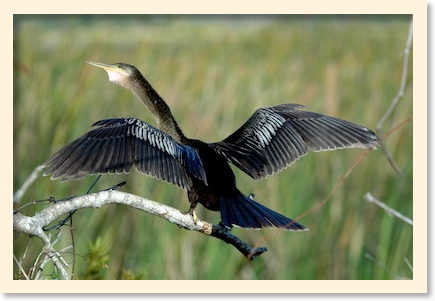The Anhinga
Article and photograph by D.W. Cloud

Found throughout the world in warm shallow waters, the anhinga is a large bird with a wingspan of up to 4 feet and a body weight of 3 pounds. It has beautiful multi-colored wings of jet black, blue, and white. The black and white wing strips resemble a keyboard and have given the creature the nickname “piano bird.” The female is distinguished from the male by its gray or light brown head, neck, and upper chest, as opposed to the glossy black of the male.
The beautiful green and blue iridescent sheen to the bird’s feathers is produced by a reflective layer of melanin granules with a keratin substrate marvelously arranged to reflect a particular portion of the light wave, similar to the way that many butterflies produce reflective coloring.
A distinguishing characteristic of the anhinga is its habit of perching and spreading its wings for long periods. This is done to dry out the feathers, as it does not have waterproofing oil glands like most other waterfowl. This is not an “accident.” It is a design feature that allows the bird to be less buoyant, as the non-oily feathers absorb water, thus enabling the anhinga to swim and hunt with its body submerged and only its long neck out of the water and to dive under water easily and stay down for long periods. It has air sacs located on various parts of its body that allow it to control its level of buoyancy in the water.
To take off from the water, the anhinga flaps its wings vigorously and “runs along the water” until it achieves flight.
The anhinga spears fish with its long sharp bill, using its long neck to strike out quickly. “The rapid stabbing motion is made possible by the anhinga’s unusual arrangement of neck vertebrae. The eighth and ninth vertebrae form a kind of hinge-like mechanism that allows the head and bill to snap forward at a high rate of speed, so fast that very few fish escape” (Russ Heitz, Krazy Kritters of Florida).
It then brings the fish to the surface, flips it in the air, and swallows it, or if the fish is larger, the anhinga takes it to shore and pries it off by rubbing it against an object such as rock or tree.
Anhingas form lifelong mating pairs and in breeding season they have a beautiful blue ring around the eyes. They build their nests in trees, particularly on branches that extend out over water, and the male and female take turns incubating the eggs. When the chicks are three weeks old, they can drop out of the nest into the water and by six weeks they begin their first attempts at flight.
A flock of anhingas is called a “kettle.”


